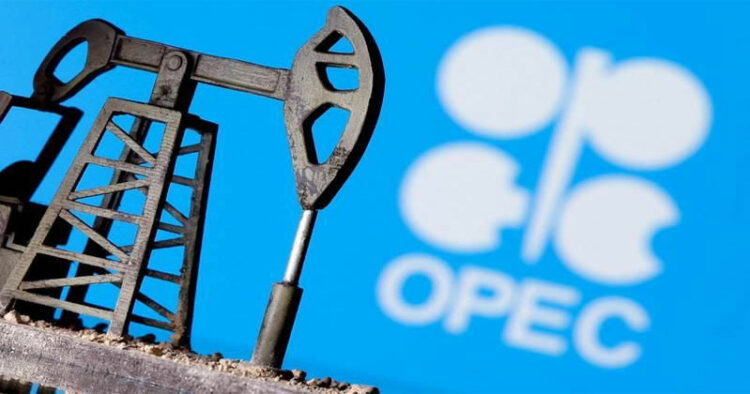Saudi Arabia and other Organisation of the Petroleum Exporting Countries (OPEC+) oil producers on April 2 announced further oil output cuts of around 1.16 million barrels per day, in a surprise move that analysts said would cause an immediate rise in prices and the United States called inadvisable. OPEC+ accounts for over 40 per cent of the world’s crude oil production.
The development comes a day before a virtual meeting of an OPEC+ ministerial panel, which includes Saudi Arabia and Russia, and which had been expected to stick to 2 million bpd of cuts already in place until the end of 2023.
The cuts commence in May and last through the end of the year, an official with the Saudi Ministry of Energy was quoted as saying by Saudi state-run news agency Saudi Press Agency (SPA). The reductions are on top of those announced by OPEC+ in October. The ministry referred to the action as a “precautionary measure” aimed at keeping the oil market stable.
How is it going to impact the global oil market?
This move has brought forth the concerns of inflationary pressures, aggressive monetary tightening by central banks that may drag the global economy into recession, according to several analysts.
The pledges bring the total volume of cuts by OPEC+, which groups the Organisation of the Petroleum Exporting Countries with Russia and other allies, to 3.66 million bpd according to Reuters calculations, equal to 3.7 per cent of global demand.
Saudi Arabia now says it will cut oil production by another half a million barrels a day. Meanwhile, Iraq will slash production by 200,000 barrels per day, and the United Arab Emirates will decrease output by 144,000 barrels per day. Kuwait, Algeria and Oman will also lower production by 128,000, 48,000 and 40,000 barrels per day, respectively.
Russia’s Prime Minister Alexander Novak also said that Moscow would extend a voluntary cut of 500,000 bpd until the end of 2023. Moscow announced those cuts unilaterally in February following the introduction of Western price caps.
Russia is saying that as the global oil market is going through a period of unprecedented volatility due to the ongoing economic uncertainty in the West. It is important to have stability, transparency in the global oil market to ensure long-term goals to sustain energy security are fulfilled that the West’s shortsightedness has ignored.
Meanwhile, India, which is the third largest importer of oil, relies on OPEC and its allied countries for more than 70 per cent of its crude oil needs.
According to reports, India has recently increased its imports of low-cost oil from Russia, which is now the second-largest supplier after Saudi Arabia. In India, petrol and diesel prices remain stagnant on April 3 for the 11th consecutive month. The last revision of fuel prices took place in May 2022. Thus, OPEC’s oil production cut fails to affect oil prices in India.
On the other hand, several experts and analysts have claimed that unexpected production cuts by OPEC members of 1.16 million barrels per day might increase oil prices globally by $10 per barrel.
Oil prices surged as much as 8 per cent at the open after OPEC+ announced it was slashing the oil output.
Goldman estimated the output reduction could provide a 7 per cent boost to oil prices, contributing to higher Saudi and OPEC+ oil revenues.
“Any unexpected 1 million barrel per day change in supply or demand conditions over the course of a year can impact prices between $20 and $25 per barrel,” said Francisco Blanch, head of commodity and derivatives research at Bank of America.
“OPEC+ resumed its recently-abandoned decision to become the ‘central bankers’ of oil,” Citi analysts including Ed Morse and Francesco Martoccia said.
The announced cuts from OPEC+ will amount to “about 1.1 per cent of global supply in the next two months and about 1.6 per cent of global supply in the back half of this year,” said Vivek Dhar, Commonwealth Bank of Australia’s director of mining and energy commodities research.
The US has been asking Saudi Arabia and other allies to increase production as it tries to bring down prices and squeeze Russia’s finances, but to no avail.
The White House pushed back on that notion — as well as the latest cuts by OPEC+. “We don’t think cuts are advisable at this moment given market uncertainty — and we’ve made that clear,” a spokesperson for the National Security Council said. “We’re focused on prices for American consumers, not barrels.”
Is Russia adding salt on the wounds? Some have perceived this move as further production cuts may push oil prices toward the $100 mark again, which will lead to China’s reopening and Russia’s output cuts as a retaliation move against western sanctions. Also suggested that the oil cartel and its allies are looking to avoid a repeat of the 2008 crash.



















Comments